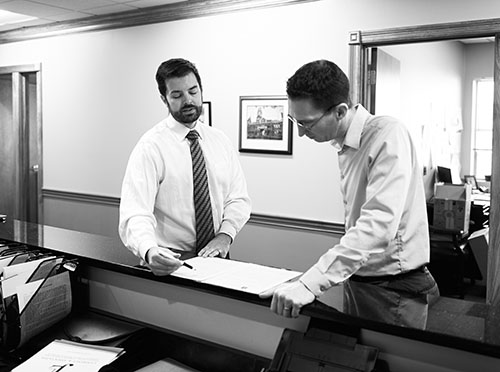Liability for Asbestos Exposure: The Story of Mary and Clayton
Posted on Tuesday, May 30th, 2017 at 10:58 am
The following post is part of our Law Student Blog Writing Project, and is authored by Linda Long, a Juris Doctor student at the NKU Salmon P. Chase College of Law.
The case Boley, Exr. et al., Appellants v. Goodyear Tire is the story of a husband and wife whose normal day-to-day routine led to a terrible disease and a big corporation not accepting responsibility for it.
Mary Adams and her husband Clayton had a pretty typical life. That life included Clayton going to work, day in and day out, at the Goodyear Tire Company and Mary taking care of the home. Mary, being a dutiful wife, always washed Clayton’s work uniforms. This routine went on for years, Clayton working and Mary washing. A tragic interruption came into the Adams’s lives- Mary was diagnosed with mesothelioma in March of 2007. She struggled with the disease, and died in July of 2007.
After Mary’s untimely death, Clayton and the executor of Mary’s estate gave it a lot of thought and concluded that Mary developed mesothelioma because of the debris that was collected on Clayton’s uniform. Clayton and the executor reasoned that because the Goodyear Tire Company used chemicals that contained asbestos, asbestos residue was left on Clayton’s uniform, and Mary inhaled it as she laundered Clayton’s uniform causing the development of the disease. After coming to that conclusion, Clayton and Mary’s executor filed a lawsuit against a group of about 200 defendants (including Goodyear Tire Company). Goodyear moved for summary judgment, arguing that the prevailing law did not provide a remedy against the company. Clayton and Mary’s executor raised the counterargument that the prevailing law applies only to premises, and that liability claims and therefore the law does not prevent their claim.
Procedural History of Claims
The trial court ruled in favor of Goodyear Tire Company’s movement for summary judgment. The court of appeals affirmed the decision of the trial court. The court of appeals held that R.C. 2307.941 (A) (1) precluded liability with regard to the alleged claims because of Mary’s exposure to asbestos did not occur at Goodyear’s property. The current opinion comes from the Supreme Court of Ohio. The question presented before the court at this level was whether R.C. 2307.941 (A) applies to, what the court called, ‘take home exposure’. This means that the court had to decide if the controlling law is applicable to exposure that is indirect, since Mary was not exposed on the premises but at her own home.
Controlling Law R.C. 2307.941 (A) (1)
 The Ohio law that is being reviewed in this case is Ohio Revised Code section 2307.941 (A) (1). This statute was specifically enacted to address the health issues that the mass use of asbestos caused. It is better stated as follows: “[t]he current asbestos personal injury litigation system is unfair and inefficient, imposing a severe burden on litigants and taxpayers alike.” The legislative intent behind this bill is to protect citizens from the effects of asbestos. The Ohio Supreme Court reviewed specific areas of the statute to come to a conclusion in Clayton and Mary’s case.
The Ohio law that is being reviewed in this case is Ohio Revised Code section 2307.941 (A) (1). This statute was specifically enacted to address the health issues that the mass use of asbestos caused. It is better stated as follows: “[t]he current asbestos personal injury litigation system is unfair and inefficient, imposing a severe burden on litigants and taxpayers alike.” The legislative intent behind this bill is to protect citizens from the effects of asbestos. The Ohio Supreme Court reviewed specific areas of the statute to come to a conclusion in Clayton and Mary’s case.
One of the portions of this statute that is relevant here is deals with where the exposure occurs. “A premises owner is not liable for any injury to any individual resulting from asbestos exposure unless that individual’s alleged exposure occurred while the individual was at the premises owner’s property.” This is the language that both the trial court and the court of appeals hung their hats on, because the exact language states that an owner is only liable if the injured person is injured while on the owner’s premises. This is important because Mary was not injured on the Goodyear premises when she was injured. That was a huge hurdle for Clayton and the executor.
So, one issue is statutory interpretation. “In cases of statutory construction, ‘our paramount concern is the legislative intent in enacting the statute.” With that precedent, things did not look good for Mary and Clayton, but the real determinative factor is intent.
To determine intent the court will look to the language of the statute and the purpose that the legislator wanted to accomplish by the statute. The Ohio Supreme Court said that its role to evaluate a statute “as a whole”. The court found that the legislative intent was apparent. The intent was to protect owners from tort liability when someone is injured while off their premises. Just like regulations were put into place to protect society at large from the damaging effects of asbestos, there are laws in place to protect the owners of property, for better or worse.
The argument that Mary’s executor and husband presented claimed that the words “exposure to asbestos” modified “on the premises owner’s property.” The court cited concerns with this interpretation. The court reasoned that going with this interpretation would eliminate the power of subdivision (A) (1); which, was meant to protect individuals who are property owners. So, the court had a serious balancing act to consider: protect the property owners or protect the individuals?
The Ohio Supreme Court’s Ruling
Overall, the court affirmed the ruling of the lower court. The Ohio Supreme Court ruled that a premises owner is not liable in tort because of the language in R.C. 2307.941 (A) (1). That means that any claim that arises from asbestos exposure that originates from asbestos from the owner’s property unless the exposure occurred at the owner’s property. So, what does this mean for Mary? Well, it is pretty simple, Mary’s executor and Clayton are now out of luck. Based on your definition of ‘fair,’ you may be disappointed by this outcome, but this was a ruling that was absolutely based on the law.
Personally, my knee jerk reaction to this ruling is that it is unfair. I think that it is unfair because, as I understand it, but for the actions of Goodyear, then Mary would not have (or her chances would have been dramatically lower) contracted mesothelioma and she would not have subsequently died. But for the actions and practices of Goodyear, Clayton would not have lost his wife in this way. For those reasons, this ruling saddens me. However, this was a ruling based on law, and Mary’s family will have to heal in another way.









